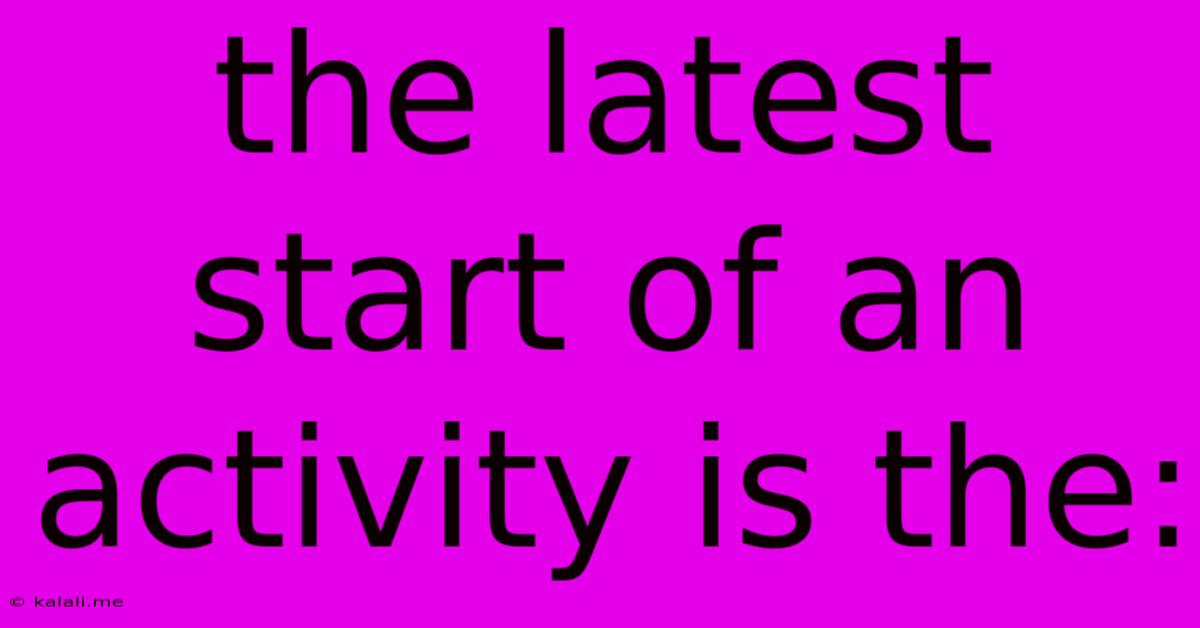The Latest Start Of An Activity Is The:
Kalali
Jun 12, 2025 · 3 min read

Table of Contents
The Latest Start of an Activity is the: Critical Path Method Explained
Finding the latest start time for an activity in a project is crucial for effective project management. This is especially true when utilizing the Critical Path Method (CPM), a technique used to determine the shortest possible time to complete a project. Understanding the latest start time helps identify potential delays and allows for proactive management. This article will explain what the latest start of an activity is and how it's determined within the context of CPM.
Understanding the latest start time helps in scheduling and resource allocation. By knowing when an activity must start at the latest to avoid delaying the overall project, managers can optimize their schedules and prevent bottlenecks. This is particularly useful for large projects with many interdependent tasks.
What is the Critical Path Method (CPM)?
The Critical Path Method (CPM) is a project management technique used to identify the sequence of tasks that determine the shortest possible duration of a project. It involves analyzing the dependencies between tasks, estimating their durations, and identifying the path with the longest duration – the critical path. Any delay on the critical path directly impacts the overall project completion time.
CPM utilizes two key concepts for each activity:
- Early Start (ES): The earliest possible start time for an activity, considering its dependencies.
- Late Start (LS): The latest possible start time for an activity without delaying the overall project completion time. This is what we're focusing on in this article.
Besides ES and LS, other essential elements are:
- Early Finish (EF): The earliest possible finish time for an activity.
- Late Finish (LF): The latest possible finish time for an activity without delaying the project.
Calculating the Latest Start (LS) Time
Calculating the latest start time involves working backward through the project network diagram. You begin with the project's overall completion date and then subtract the activity durations. Here's a step-by-step process:
-
Determine the Project's Completion Time: First, identify the critical path and its total duration. This represents the shortest possible project completion time.
-
Work Backwards from the End: Start with the last activity on the critical path and determine its Late Finish (LF) time. This will be the same as the project's overall completion time.
-
Calculate Late Start (LS): Subtract the activity's duration from its Late Finish (LF) time. This gives you the Latest Start (LS) time.
-
Repeat for Preceding Activities: Move to the activities that precede the one you just calculated. Their LF will be the LS of the activity you just completed. Continue this process until you reach the beginning of the project.
-
Consider Dependencies: Remember to consider the dependencies between activities. The LS of an activity cannot be earlier than the LF of its preceding activities.
Importance of the Latest Start (LS) Time in Project Management
Understanding the latest start times for all activities within a project is vital for several reasons:
-
Identifying Slack/Float: The difference between the Late Start (LS) and Early Start (ES) of an activity is called slack or float. Activities with zero slack are on the critical path; any delay here impacts the project completion time.
-
Resource Allocation: Knowing the LS allows for efficient resource allocation. Resources can be strategically assigned to activities with tight deadlines (minimal slack) to prevent delays.
-
Risk Management: Identifying activities with minimal slack highlights potential bottlenecks and allows for proactive risk mitigation strategies.
Conclusion
The latest start of an activity, calculated using the Critical Path Method, is a fundamental concept in project management. By understanding and utilizing this information, project managers can better schedule tasks, allocate resources, and manage risks to ensure projects are completed on time and within budget. Mastering CPM and its associated calculations is crucial for successful project delivery.
Latest Posts
Latest Posts
-
Which Of The Following Statements Is True Of The Buddha
Jun 13, 2025
-
How Many Neutrons Are In An Atom Of Uranium 235
Jun 13, 2025
-
How Much Legs Does A Ant Have
Jun 13, 2025
-
Is Soda An Acid Or Base
Jun 13, 2025
-
The Post Office Of The Cell Is The
Jun 13, 2025
Related Post
Thank you for visiting our website which covers about The Latest Start Of An Activity Is The: . We hope the information provided has been useful to you. Feel free to contact us if you have any questions or need further assistance. See you next time and don't miss to bookmark.